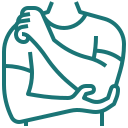"*" indicates required fields

Your elbow is the hinge of the arm. You use it in a range of motions every day, for many things. If you have ever had ‘tennis elbow’, or any other kind of elbow pain, you will know how much even a minor twinge can impact on your daily ability to work, interact with your family and loved ones, or play sports.
The elbow joint acts like a hinge to allow the arm to bend and straighten. It also allows you to turn your palms up or down by rotating the forearm.
Elbow injuries are common in the workplace; in 2018-19 in Australian workplaces, 2,835 of all upper limb injuries (a total of 40,145 injuries) were reported for injuries to the elbow. The causes of injuries varied, and the injuries themselves took a range of forms, including cuts, crushing, fractures, wounds, and ligament damage.
Elbow injuries can also happen as a result of trauma through car accidents, or wounds and injuries suffered in a public place. Elbow injuries can be difficult to treat and overcome due to the critical role the elbow plays in daily movement, and also due to the way in which the elbow is made up. Treatment for an elbow injury can take some time, and you may need to take some time off work to recover if you have suffered an elbow injury.
If your elbow injury has been caused as a result of someone else’s negligence, you may be able to seek compensation for the damage you have suffered and the financial loss associated with your injury. Speak to our no win no fee accident lawyers at Murphy's Law Accident Lawyers today about your elbow injury compensation claim and find out where you stand.


The elbow is prone to damage in a number of ways, from fractures and breaks through to soft tissue damage and tendon injury. Symptoms of elbow injury may include a dull ache, pain when making a fist or extending the fingers, a weak grip, soreness, tenderness, swelling or intense pain.
We have listed some of the more common elbow injuries below.
Get legal advice about your elbow injury today and find out where you stand with possible compensation for an elbow injury. Our personal injury lawyers can help you with compensation claims and will ensure you are supported through what can sometimes be a difficult process.
While an elbow injury can happen in any number of ways, we have listed some of the more common causes of elbow injuries below.

In many cases, an elbow injury will be mild to moderate and, while it will cause discomfort and pain at the site, it can be managed with a good treatment plan, adequate rest and recovery, and suitable duties while you are recovering at work.
However, in other cases, your elbow injury will be severe and you will need to seek urgent or timely medical treatment. If you have serious pain, a sharp ache, difficulty moving your elbow, swelling, trauma, weakness of grip or any other symptoms that remains the same level of pain or worsen, you should seek medical treatment to rule out the possibility of a serious injury.
Similarly, if you have had an elbow injury at work you need to seek medical treatment and diagnosis as soon as you are able so that you can make the necessary WorkCover claim for your injuries and any loss of income.

Some occupations are at a higher risk of workplace injury due to the nature of the work undertaken. The occupations with high elbow injury risks include:
Workplace elbow injuries are painful and difficult, but with the right treatment you will be on track to getting back to work as safely as possible. WorkCover claims and common law claims for negligent workplace conduct can ensure you have access to the financial support you need to recover in the best possible way for your current and future health.

When calculating the amount of compensation payable for an elbow injury, the amount is reached by taking into account the following factors:
If you have suffered an elbow injury that is permanent, you will also be able to claim for a permanent impairment which is calculated by considering the type of injury you have suffered, and making a payment for the total impact the injury has on your life.

Personal injury claims for elbow injuries generally need to be commenced within three years of the date you suffered your injury. There are also specific times frames which apply to injuries which have been suffered in the workplace, and injuries that occurred in a public place.
You can read more about the time limits for particular situations here, or contact our personal injury lawyers today to find out more about the process of making a claim for an elbow injury.
It is helpful to speak to a lawyer as soon as you are able so that you know where you stand in regard to making a claim. You do not want to miss the opportunity of being able to make a claim for your elbow injury due to running out of time.